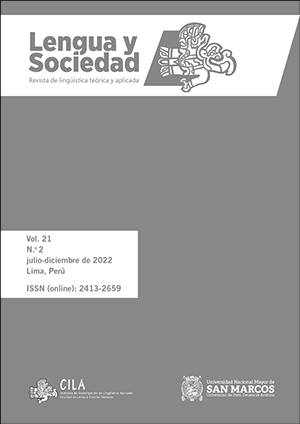The question of the textbook for teaching a foreign language and the role ofthe teacher before adopting it
DOI:
https://doi.org/10.15381/lengsoc.v21i2.22572Keywords:
didactic book, research, context, teacher, learnerAbstract
The didactic book represents one of the main working tools for the teacher throughout the teaching and learning process. However, in view of the growing number of researches on this material, it is observed that there are a series of problems that involve not only aspects related to its content, but also to how it is being received in the institutions. The main objective of this article is to highlight some questions that surround textbooks for teaching a foreign language (FL) from bibliographical research on works that have been based on the analysis of FL textbooks. In addition, this article discusses the role of the teacher before adopting it. The points of view of Coracini (2021) and Taset (2015) contribute to clarify some points on this topic. It is recognized the importance of the teacher's training to be able to adapt the didactic book according to its context of use and to know the main needs of the learners in relation to the language they intend to study.
References
Almeida, J. (1997). “A abordagem orientadora da ação do professor”. In: ALMEIDA FILHO, J.C.P. (Org.). Parâmetros Atuais no Ensino de Português Língua Estrangeira. Pontes.
Andrijević, M. (2010). Reflexiones en torno al uso de los materiales auténticos en la enseñanza de lenguas extranjeras. Colindancias, 1, 157-163. https://colindancias.uvt.ro/index.php/colindancias/article/view/113/95
Campos, F. (2017). Variação linguística no livro didático de PLE e sua percepção pelo professor. Revista Sociodialeto, 7(21), 20-51. http://sociodialeto.com.br/index.php/sociodialeto/article/view/54
Coracini, M. (2021). Funcionamentos discursivos de livros didáticos e materiais didáticos: entrevista com Maria José Coracini. Dossiê Funcionamentos discursivos de livros didáticos e de materiais didáticos: possibilidades de análise e de trabalho. Cadernos Discursivos, Catalão-GO, 1(1), 166-177. https://files.cercomp.ufg.br/weby/up/595/o/Entrevista_Coracini_2021.pdf
Cunningsworth, A. (1995). Choosing your coursebook. Oxford: Macmillan Heinemann.
Favaro, M. (2013). O livro didático de língua adicional do PNLD e o aluno local: como essa relação faz sentido em sala de aula? (tesis de maestria). Universidade Federal de Santa Catarina, Florianópolis, Brasil.
Franco, A. (2009). ¿Por qué es el libro del profesor una herramienta útil? Analizando actividades. Foro de profesores de E/LE, 5, 1-8. https://roderic.uv.es/handle/10550/64965
González, M. (2016). Análisis metodológico de manuales de español para extranjeros: últimas aportaciones y perspectivas de futuro (tesis de maestría). Universidad Nacional de Educación a Distancia, España.
González, V. (2015). Análise de abordagem de material didático para o ensino de línguas (PLE/PL2) (tesis de maestría). Universidade de Brasília, Distrito Federal, Brasil.
Hutchinson, T. (1987). What’s underneath? An interactive view of material evaluation. In: L. E. Sheldon (Ed.). ELT Textbooks and Materials: Problems in Evaluation and Development. Gran Bretaña: Modern English Publications. https://www.teachingenglish.org.uk/article/elt-textbooks-materials-problems-evaluation-development
Littlejohn, A. (1998). The analysis of language teaching materials: Inside the Trojan Horse. En B. Tomlinson (Ed.), Materials Development in Language Teaching (pp. 190-216). Cambridge University Press.
Littlejohn, A. (2011). The analysis of language teaching materials: Inside the Trojan Horse. En B. Tomlinson (Ed.), Materials Development in Language Teaching (pp. 179-211), Cambridge University Press.
López, C., García, Y. y Verde, R. (2021). Documentación lingüística-cultural y producción de prototipos de material educativo para el desarrollo de programas de fortalecimiento y revitalización del quechua en asentamientos humanos del distrito de Los Olivos-Lima. Lengua y Sociedad, 20(1), 101-124. https://doi.org/10.15381/lengsoc.v20i1.22271
Mantasiah, R.; Yusri, Muhammad, A. y Hasmawati. (2021). Integrating Linguistics Theories in Developing Foreign Language Teaching Material (German Grammar Textbook for Indonesian Learners). International Journal of Language Education, 5(3), 125-134.
Mendes, K. (2006). Português língua estrangeira: uma análise do livro didático (Tesis de Maestría). Universidade Federal da Bahia. Repositório Institucional da UFBA. https://repositorio.ufba.br/handle/ri/11638
Morita, M. (1998). (Re)Pensando sobre o material didático de PLE. In R. C. Pagliuchi da Silveira (Org.). Português língua estrangeira: perspectivas. Cortez.
Sarmento, S. y Heyde, D. (2016). O papel do livro didático no ensino de inglês: aspectos sobre sua importância, escolha e utilização. Revista (Con)Textos Linguísticos, 10(17), pp. 291-300. https://periodicos.ufes.br/contextoslinguisticos/article/view/14805#:~:text=Para%20que%20o%20livro%20did%C3%A1tico,escolha%2C%20uso%20e%20adapta%C3%A7%C3%A3o).
Tang, S. (2015). Aspirações e dificuldades: Livro didático como instrumento de Interação-professor e aluno (Tesis de maestria). Universdidad de São Paulo.
Taset, I. (2015). O tratamento do componente cultural no livro didático Aula 2 para o ensino de E/LE. Revista Letras Raras, 4 (3), 63-74. http://dx.doi.org/10.35572/rlr.v4i3.463
Vieira, M., Alves, K., de Melo, O., Pereira, D., & da S. G. Toledo, S. (2020). A diferença do uso e não uso do livro didático em duas escolas nas aulas de língua inglesa. desafios. Revista Interdisciplinar Da Universidade Federal Do Tocantins, 7(Especial-2), 34-38. https://doi.org/10.20873/uftsupl2020-8810
Yang, A. y Cheung, C. (2003) Adapting Textbook Activities for Communicative Teaching and Cooperative Learning. English Teaching Forum, 41(3), 16-24. https://americanenglish.state.gov/files/ae/resource_files/03-41-3-d.pdf
Zhao, B. (2015). Análisis de materiales didácticos para la enseñanza de chino a Españoles (tesis de doctorado). Universidad Complutense de Madrid. https://eprints.ucm.es/id/eprint/39976/
Downloads
Published
Issue
Section
License
Copyright (c) 2022 Simone de Meneses Mitma

This work is licensed under a Creative Commons Attribution 4.0 International License.
AUTHORS RETAIN THEIR RIGHTS
a. Authors retain their trade mark rights and patent, and also on any process or procedure described in the article.
b. Authors can submit to the journal Lengua y Sociedad, papers disseminated as pre-print in repositories. This should be made known in the cover letter.
c. Authors retain their right to share, copy, distribute, perform and publicly communicate their article (eg, to place their article in an institutional repository or publish it in a book), with an acknowledgment of its initial publication in the journal Lengua y Sociedad.
d. Authors retain theirs right to make a subsequent publication of their work, to use the article or any part thereof (eg a compilation of his papers, lecture notes, thesis, or a book), always indicating its initial publication in the journal Lengua y Sociedad (the originator of the work, journal, volume, number and date).



























